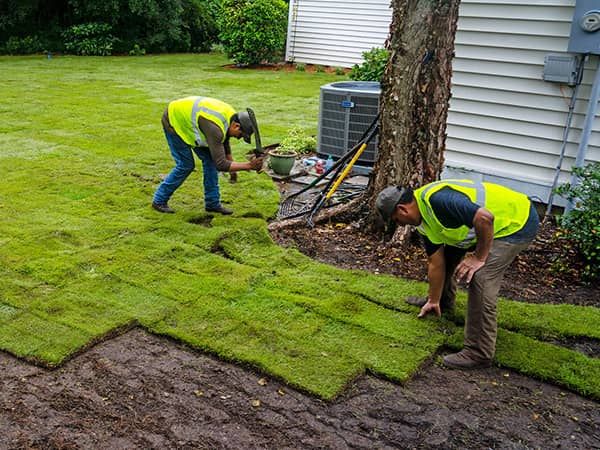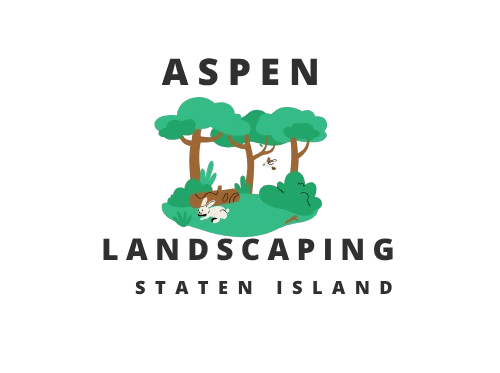Sod Installation
Proper sod installation is essential to achieve a lush, green, and healthy lawn that enhances curb appeal and provides benefits such as erosion control, improved air quality, and temperature regulation. Homeowners and commercial property managers often face challenges—from site preparation and soil testing to precise irrigation and post-installation care. This article examines the two most common methods of sod installation: artificial sod installation and traditional sod installation. It explains the technical steps involved, outlines the benefits and potential pitfalls of each method, and offers data-driven insights to help customers make informed landscaping decisions.
Today’s competitive landscaping industry demands outcomes that stem from decades of experience and an understanding of turf biology and soil dynamics. With over 20 years of expertise, companies like Aspen Landscaping Staten Island use the finest materials to ensure every installation meets rigorous standards for durability and satisfaction. This article highlights technical recommendations and industry best practices while connecting insights with real-world scenarios—from adjusting irrigation methods to using specialty soil amendments that promote rapid root growth. By addressing common challenges and comparing artificial and natural sod installations, this article provides guidance for making the best investment in your property’s landscape.The article will begin by detailing sod installation processes and best practices under the main heading “Sod Installation.” Following that, it will cover the differences and advantages of artificial sod installation and conventional sod installation, each explained with clear, query-formatted subheadings. Each section is designed to be comprehensive and data-driven, focusing on benefits, performance, and maintenance requirements.
Key Takeaways
- Aspen Landscaping Staten Island Offers Professional Sod Installation Services for Both Natural and Artificial Sod in Staten Island
- Their Comprehensive Installation Process Includes Thorough Soil Preparation, Precise Cutting and Fitting, and Proper Maintenance Techniques
- Aspen Landscaping’s Team Evaluates Soil Conditions, Prepares the Area, and Provides Detailed Care Instructions for Natural Sod Installations
- For Clients Seeking a Low-Maintenance Alternative, their Landscaping Westchester Company Offers Expert Artificial Sod Installation Using High-Quality Synthetic Turf Products
- The Artificial Sod Installation Process Involves Thorough Site Preparation and Secure Placement for a Seamless, Natural Appearance
Artificial Sod Installation
Artificial sod installation uses synthetic turf materials to replicate natural grass aesthetics while eliminating many ongoing maintenance tasks. It is especially suited for commercial landscapes, sports fields, and areas with water conservation needs. This method involves preparing a stable substrate, laying down a specialized shock-absorbent layer, and installing synthetic turf with precise adhesion techniques.
The process begins with evaluating the installation area. Unlike natural sod that requires nutrient-rich soil for live grass, artificial sod depends on a stable, well-compacted base to prevent shifting and wrinkles. Typically, existing vegetation and debris are removed, and the soil is graded to create a perfectly flat surface. A permeable layer of crushed stone or specialized infill material is spread to enhance drainage and minimize water pooling, which helps prevent premature wear during heavy use.
Once the base is prepared, a geotextile fabric is often laid to stabilize the surface and prevent weed growth. The synthetic turf, delivered in rolls, is unrolled and secured with strong adhesives and mechanical staples. Turf seams are aligned carefully to ensure a continuous, visually appealing appearance that mimics the natural interlocking pattern of grass blades. Using industrial-grade cutting equipment ensures clean edges and avoids unsightly overlaps.
Primary benefits for artificial sod installation include:
- Low Maintenance – Eliminates the need for mowing, watering, and fertilizing.
- Durability – Engineered to withstand weather, heavy foot traffic, and UV degradation.
- Aesthetic Consistency – Maintains a uniformly green appearance year-round.
- Water Conservation – Ideal for regions with limited water supplies.
- Enhanced Safety – Provides non-slip surfaces ideal for recreational areas.
Incorporating advanced technology into the installation process has reduced installation time by up to 30% compared to traditional methods. Modern synthetic turf is engineered with UV stabilizers and recycled materials, offering both an exceptional appearance and eco-friendly benefits.
Cost efficiency is another advantage. Although the upfront cost is higher, long-term savings on maintenance and replacement are significant. Homeowners and commercial property managers benefit from reduced labor, lower water usage, and decreased expense for maintenance equipment. For school playgrounds and sports facilities, the durability of synthetic turf translates into increased usability and safety over its lifespan.
A table summarizing the differences between artificial and natural sod installation techniques is provided below:
| Factor | Artificial Sod Installation | Natural Sod Installation |
| Maintenance Requirements | Minimal – no mowing or watering needed | High – requires regular mowing, watering, and fertilization |
| Durability | High – designed for heavy use and weather resistance | Moderate – subject to seasonal wear |
| Installation Cost | Higher upfront cost; lower long-term expenses | Lower upfront cost; higher ongoing maintenance costs |
| Environmental Impact | Conserves water; uses recycled materials | Requires significant water and chemical inputs |
| Aesthetic Consistency | Uniform appearance year-round | Can vary seasonally depending on care and weather |
This detailed examination shows that artificial sod installation offers both aesthetic and functional advantages while aligning with modern sustainability practices.

Sod Installation
Sod Installation
Traditional sod installation is the gold standard for customers seeking a living lawn that enhances environmental quality and property value. This process involves laying sections of natural grass, grown and harvested on specialized farms, to create an instant green space that integrates with the local ecosystem. It requires careful soil preparation, precise cutting, accurate layout, and diligent post-installation care to ensure rapid rooting and sustained growth.
The initial phase of traditional sod installation is site preparation. Experts begin by clearing the area of existing vegetation, debris, and even previous sod. The soil is tilled deeply to improve aeration, allowing water and nutrients to reach the new sod. After incorporating organic compost or other soil amendments, the ground is leveled using mechanical graders. This creates a uniform surface that prevents uneven water distribution and promotes deep root penetration.
Once the ground is prepared, the sod strips are laid in staggered rows to mimic the natural interlocking growth pattern of a healthy lawn. It is critical that the edges of each piece contact one another closely to prevent drying and weed infestations. Heavy rollers are then used to press the sod pieces firmly into the soil, eliminating air pockets that could impede root growth. Proper irrigation is initiated immediately—typically an initial deep soak followed by daily light watering that gradually decreases as the roots develop.
The benefits of traditional sod installation are numerous. Natural sod provides a soft, comfortable ground cover while improving local air quality through carbon dioxide absorption and oxygen release. It also helps reduce urban heat island effects and contributes to noise reduction. While natural sod does require periodic maintenance such as mowing and fertilization, these practices stimulate vigorous growth and improve overall lawn health over time.
Key factors contributing to successful sod installation include:
- Comprehensive Site Preparation – Ensures optimal soil health and drainage.
- Precise Sod Layout – Reduces gaps and creates a seamless appearance.
- Immediate Rolling and Irrigation – Promotes quick root establishment.
- Ongoing Maintenance – Critical for long-term turf health.
- Soil Fertility and Amendments – Enhance nutrient availability and moisture retention.
Professional landscapers combine manual expertise with modern technology to meet high standards of durability and visual appeal. Customer testimonials frequently report improvements in property value and satisfaction following a well-installed sod lawn. For example, refreshed landscapes have been shown to increase property values by up to 10%.
The table below details a comparison of maintenance requirements, installation costs, and long-term benefits between natural sod and artificial turf:
| Parameter | Natural Sod Installation | Artificial Turf Installation |
| Initial Installation Cost | Low to moderate | High |
| Maintenance Requirements | High – regular mowing, watering, and fertilizing | Low – minimal upkeep |
| Longevity | 5-10 years with proper care | 15-20 years |
| Environmental Impact | Improves air quality; supports local biodiversity | Conserves water; available in recycled options |
| Aesthetic Evolution | Develops character over seasons | Remains uniformly green year-round |
Post-installation care is critical, particularly for natural sod, which requires attentive follow-up in the first few weeks. Regular mowing at the recommended height, targeted weed management, and timely fertilization help the lawn become robust and self-sustaining. Experts also suggest periodic soil testing to monitor moisture and nutrient levels for optimal growth.
